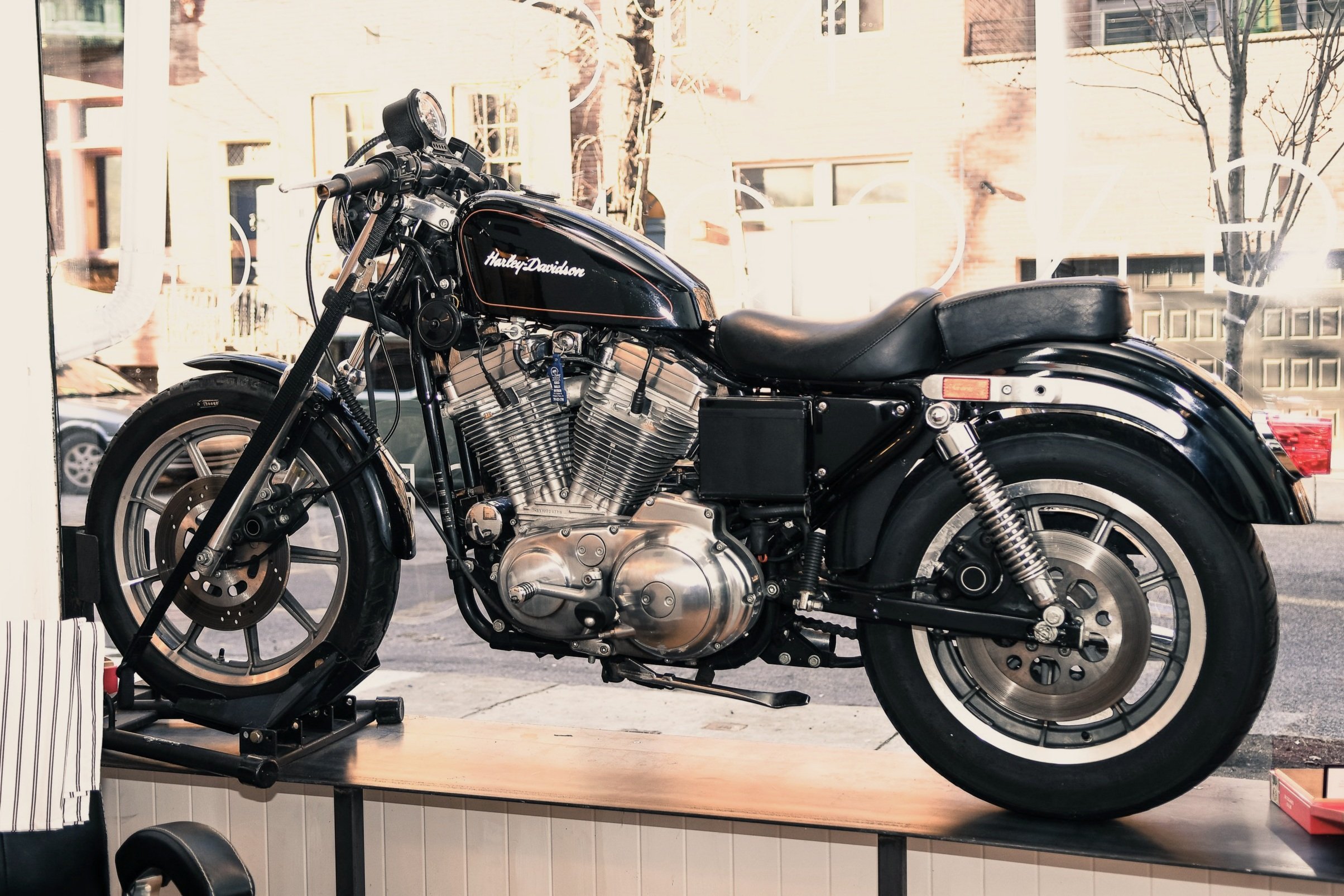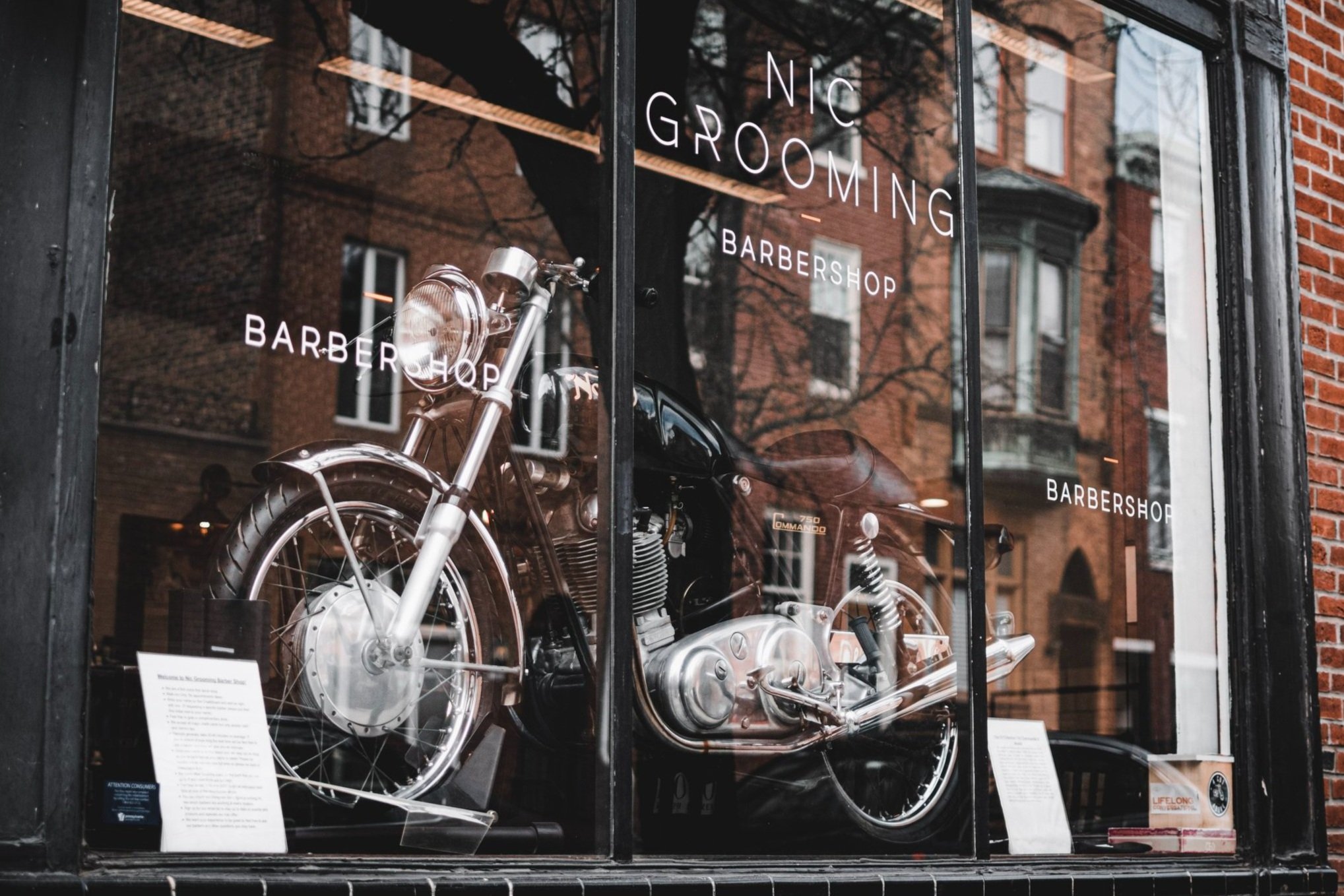What’s in Our Shop Windows?
Haircuts aren’t the only thing we like to keep edgy.
Learn the history the motorcycles currently on display at Nic Grooming Barbershop and discover our rotating collection of bikes that are available for purchase.
If you’re interested in purchasing one of current motorcycles on display, please contact us for more information.
1967 Moto Guzzi Dingo
on display at our Sansom Street shop in Center City Philadelphia, Pennsylvania
Established in 1921 in Mandello del Lario, Italy, the company is noted for its historic role in Italy's motorcycling manufacture, its prominence worldwide in motorcycle racing, and industry innovations—including the first motorcycle center stand, wind tunnel and eight-cylinder engine.
In February 1967, SEIMM (Società Esercizio Industrie Moto Meccaniche), a state-controlled receiver, took ownership of Moto Guzzi. The SEIMM oversight saw Moto Guzzi adapting to a cultural shift away from motorcycles to automobiles. The company focused on popular lightweight mopeds including the Dingo and Trotter – and the 125 cc Stornello motorcycle.
Like the Guzzino, the motor was designed by Antonio Micucci, who was the go-to man at the factory if you needed a two-stroke! The Dingo evolved over the years through several models.
Other Dingo models included the Cross dirt bike and MM automatic. In all, 12 different models were built from 1963 to 1976. They were also produced under license in Spain.
1992 Harley Davidson Sportster
on display at our Pine Street shop in Center City Philadelphia, Pennsylvania
The Harley Sportster has been the most successful product lineup Harley Davidson has ever created. It has made its mark on nearly every niche in motorcycling, and its capability is so broad that it has been characterized as everything from the ultimate stud machine to a two-wheeled street rod to a great bike for women.
One of the reasons why the Sportster has been characterized as the “do-it-all bike” is because it has been in continuous production since 1957. It has received a lot of product development and improvement over those 60 years, making it one of the longest produced motorcycle models in the world.
The 1992 model features some changes from previous models, such as a five-speed transmission, rubber-mounted foot pegs and belt final drive on the 883 Deluxe. As of 2023, Harley Davidson still offers five different models of their Sportster.
1970 Norton 750 Commando S Model
currently on display at our Pine Street shop in Center City Philadelphia, Pennsylvania
This model was introduced at the same time as the 'R' and made its debut in March 1969.
The styling of this particular type is more to American tastes than the traditional British style, with the fitting of high bars, a smaller petrol tank, ungartered forks and a high exhaust system with both pipes on the left-hand side of the machine. A shield was a necessary fitment over the pipes to protect the riders. The exhaust line, being a little shorter than that of the Fastback model, gives the 'S' Type slightly different power characteristics.
Other distinguishing features of the 'S' Type are a quilted finish to the dual seat and a chromed 'crash bar' around a smaller styled headlamp. The 'S' type was the basis for the Roadster model, which was virtually identical except for a low-level exhaust.
1973 Norton Commando 750
currently on display at our Pine Street shop in Center City Philadelphia, Pennsylvania
When it debuted in 1968, the 750cc Commando was Norton’s swansong. It was the last of the company’s big twins that dated back to the 500cc Dominator of 1949, and its ingenious “isolastic” rubber blocks separated the rider from the potential discomforts of the vibration-prone engine and gearbox.
Norton certainly had its share of financial troubles at the time, but the new Commando nevertheless created enormous interest, largely thanks to its styling. The forward sloping engine, the fastback bodywork and the upswept megaphone exhausts gave it a racy, aggressive look that resonated with a lot of riders.
It was a looker, but the Commando also very much delivered in the performance department. The OHV parallel twin made 58 bhp at 6,800 rpm and could propel the 418 pound bike to a top speed of 117 mph. Handling was quite good thanks to the featherbed frame and Motor Cycle News readers voted it bike of the year five years straight from 1968-72.
1963 Honda CB77 Super Hawk
currently on display at our Chestnut Street shop in Old City Philadelphia, Pennsylvania
Honda's Super Hawk dramatically changed the face of the motorcycle world. No other motorcycle before it contained as many features for so few dollars. Powered by an inclined vertical twin engine that could be revved to 9,200 r.p.m., the bike also included 12-volt alternator electrics, electric start, chain-driven overhead camshaft, and wet sump lubrication. Perhaps the biggest plus was the fact the Super Hawk didn't mark its spot wherever it was parked.
In 1961, when the Super Hawk was introduced, it seemed acceptable for a British or American made machine to ooze and dribble lubricant. But with Honda's horizontally split crankcases and proper seals around kickstart and gearshift spindles the Super Hawk was virtually oil tight.
In America, Honda introduced both the CB72 Hawk and CB77 Super Hawk at the same time. The smaller machine, the CB72, featured a 247cc engine. The CB72's bigger brother, the CB77, had an odd displacement of 305cc's.
Regardless, the CB77 Super Hawk was really a firecracker. One only needs to read the Cycle World Road Test of 1964 to understand the impact the Super Hawk really had.
"Never before, in the entire history of motorcycling, has one company done so much in so little time," Cycle World enthused in its report. "There are, naturally, excellent reasons for this progress: from top to bottom, the Honda line of motorcycles features good performance, good handling, good quality, and a high degree of technical refinements. The fastest and most refined of all Hondas is the CB77, and it is a remarkable machine in many respects."
1963 Aermacchi 250 CRTT
currently on display at our 20th Street shop in the Rittenhouse neighborhood of Philadelphia, Pennsylvania
Aermacchi, or Aeronautica Macchi, started out as an Italian aircraft manufacturer in 1912 when it was founded by Giulio Macchi in Varese. The company originally built Nieuport monoplanes under license for the Italian military until the end of World War I when they began building motorcycles to fill the public's post-war need for cheap, efficient transportation. The first motorcycle rolled off the production line in 1951 as a scooter/motorcycle hybrid called the "Convertible".
Throughout the years, sales of the scooters were poor and Aermacchi could not compete with Vespas and Lambrettas so they focused solely on producing motorcycles. In 1960, Harley-Davidson purchased 50% of Aermacchi's motorcycle division and changed the company's name to Aermacchi-Harley-Davidson. The American manufacturer bought the rest of Aermacchi in 1974 before they sold the rights to Cagiva, another Italian motorcycle manufacturer, in 1978 who then ceased their production two years later.
Frame #63C5014 is especially unique because of its extraordinary racing history. It is a custom-built, early example that was raced throughout the 1960s in California and the Pacific Northwest where it has lived since then. Frame #63CR5014 is equipped with a 250tc long-stroke engine, a DellOrto carburetor, and Oldani brakes, all of which are the same specifications that these motorcycles came with from the factory. It also has a period-correct Veglia race-tachometer ranging from 2,000 to 10,000 RPM.
1972 Yamaha LS2 100
currently on display inside our Chestnut Street shop in Old City Philadelphia, Pennsylvania
Debuting in 1972 and only offered in the United States for one year, the LS2 featured a 97cc, two-stroke, Yamalube oil-injected, five-port, twin-cylinder engine, which was good for a top speed of about 69 mph. Marketed as a “town and country runabout,” the LS2 was a fully equipped streetbike with 18-inch wheels, a five-speed transmission, separate speedometer and tachometer, headlight and taillight, and turn signals on both the front and rear.
Compact, yet powerful, and weighing in at just a little over 200 pounds, the bike comfortably accommodated both a rider and a passenger, and it delivered great fuel economy, which made it a big seller during America’s 1970's Energy Crisis, as young and old alike left their four-wheeled land yachts sitting in the driveway, in favor of the sweet little LS2 gas-sipper.
With its classic, early 1970’s styling, with chrome mudguards and tasteful pinstriping, it’s sure to make heads turn at any classic Japanese motorcycle festival.










